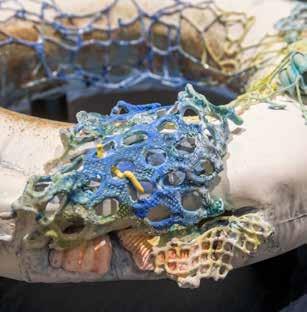
4 minute read
The State We’re In Water: Constructing a Sense of Place in the Hydrosphere
By Skylar Smith
Advertisement
Mixed media installation by Marguerite Perret with porcelain slip cast, molded and ceramic burnout specimens of debris found along fresh waterways and lakes. Photo credit: Phil Shockley
Definition of fluid: 1a: having particles that easily move and change their relative position without a separation of the mass and that easily yield to pressure: capable of flowing b: subject to change or movement 2: characterized by or employing a smooth easy style 3a: available for various uses
Merriam-Webster.com Dictionary, s.v. “fluid,” accessed September 1, 2020, www.merriam-webster.com/dictionary/fluid The State We’re In Water: Constructing a Sense of Space in the Hydrosphere, is not only an exhibition opening August 24, at the Oklahoma State University Museum of Art in Stillwater, but a new, interdisciplinary foray into building connections between art and science, students and professionals, and a museum with its local community through a medium that affects all life on Earth: water. The topic itself is broad and nimble, representative of global challenges while firmly grounded in examples found in the region and presented through a multi-media model that is equally fluid. Installation elements on display are as diverse as artfully adapted-scientific models, photographs of water in kaleidoscopic detail or shots taken by drones flying above that capture people immersed in lakes printed on metallic panels that glitter, glint, and brim with life, to video content captured and edited with the desire to maximize a viewer’s selfreflective relationship with water.
From its inception, this exhibition has been a multi-layered, communal effort. The OSUMA staff contacted a trio of artists whose works focus on socially- and scientifically-engaged topics: Marguerite Perret, who has served as lead artist on the project, Robin Lasser, a featured artist working in multimedia and photography, and Bruce Scherting, an exhibition designer. This threesome then worked to create surveys and lead a town hall meeting in order to hear what faculty, students, and local community members wanted to know more about. This initial ask led to a smaller exhibition in 2019 Katherine Hair’s whimsical, towering deer sculptures entitled, Washed Up. Later that year, the are made from discarded and recycled branches.
Installation by Perret and Scherting featuring diatoms, a major group of algae found in oceans, waterways and soils, generating 20-50% of the earth’s oxygen.


Inflatable raft cast in porcelain with coral like features emerging. Perret creates a contradiction between organic and man-made and poses reflection on humanity’s impact on water. Photo credit: Phil Shockley
OSUMA received a grant from the National Endowment for the Arts (NEA) to envision a second exhibit. The State We’re in Water, touches on similar themes and materials as the first show, but with the help of NEA funding, this next presentation allowed the artists and their partners to go deeper into the subject, theme, and medium of water.
Perret, Lasser, and Scherting, who do not reside in Oklahoma, took part in residencies where they traveled regularly to Stillwater and worked to develop the exhibition with museum staff, community partners like the Wastewater Treatment Plant for the City of Stillwater, The Prairie Arts Center, The Lake McMurtry Foundation, and Oka’ Yanahli Preserve to name merely a few, as well as faculty and students in the arts programs, environmental science programs, and architecture programs. A portion of the exhibition intended to recreate a segment of boardwalk was even designed by students of Professor Paolo Sanza of the OSU School of Architecture as part of his course. Each aspect of this exhibition exemplifies the ripple effects of a talented team of artists asking questions and incorporating information from across disciplines, organizations, and levels of learning. By focusing on a theme and allowing artists to drive the development process without a defined end goal, the exhibition was able to evolve and develop as more was learned about the lifecycles of water through individual interviews and scientific investigations.
The participants of this project were thrilled to have their three-year project come to fruition this August. However, due to challenges brought on by COVID-19, the opening and impact of the show was called into question. Through the extreme resourcefulness of the artists, the museum staff, and the generosity of a second, NEA grant (through the CARES Act), the artists and museum staff were able to re-tool their goals, ship materials to the Museum, and create even more supportive content than initially planned. The exhibit, by virtue of its focus on a medium that is often overlooked, but integral to everyone, is universal in its appeal. The museum staffers had already mirrored that universality by creating educational content geared toward students aged K-12, college students, and community members. With the assistance of the second grant, the OSUMA team pushed their engagement to the next level by investing in more distanced-learning options, like a three-dimensional, 360 tour of the exhibit that can be found online, pick-up bags filled with crafts and activities for young learners at home, and through STEAM segments and design challenges available through the Museum’s social media platforms.
Though the exhibition itself was slightly delayed and opened late August, it will run through May of 2021 so that viewers can enjoy the show over time and do so safely while social distancing. Designed to be immersive and engaging, whether viewed online or in person, The State We’re In Water: Constructing a Sense of Space in the Hydrosphere, is a refreshing sea change in the way art, science, and community come together in the museum. For more information, visit museum.okstate.edu. n
Skylar is a curator, writer, and artist living in Tulsa, OK. She is a graduate of Oklahoma State University, Dartmouth College, and Bard Graduate Center and a Fellow for the Norman Rockwell Center for American Visual Culture. sketchesbyskylar.com










